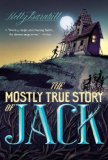Summary | Excerpt | Reading Guide | Reviews | Beyond the book | Read-Alikes | Genres & Themes | Author Bio

The Mostly True Story of Jack is downright creepy. Something very evil is lurking just beneath the surface in the small town of Hazelwood, Iowa. Literally beneath the surface - under the cornfields, under the local school, under the forest, and under the houses where Hazelwood's residents try to live normal lives. And this evil thing has come up out of the landscape before. Fourteen-year-old Frankie, and his twin sister Wendy, know this. Frankie was abducted six years earlier and came home scarred and silent. No one knows exactly what happened or why. But Frankie, Wendy, and their friend, Anders, have a strong sense that it was this sinister under-the-ground thing that is to blame.
Jack has been sent to live with his eccentric uncle and aunt in this strange and eerie town. He has spent most of his childhood feeling invisible and alone, but when he gets to Hazelwood, everyone - and everything - takes notice. Why is Jack such a focus of attention? And why does Jack feel so connected to this place that he does not know? This is where The Mostly True Story of Jack begins.
Kelly Barnhill does a brilliant job of creating just the right details to ground the reader in this spine-tingling world. Anders goes on what at first feels like a typical walk. "But on the sixth step, he felt something different. A humming sensation in the grass. On the seventh step it was stronger. By the time he had gone thirty paces, the ground pricked at his toes as though with electric shocks." Creepy. And when Jack almost gets run down by a car and falls, he realizes he is being held against his will. "His glasses itched terribly under his nose, but when he tried to adjust them, he realized that he couldn't move his right arm. Or his left. Tendrils of grass and ivy slithered along his side. They twined around his ankles and wrists and held him tight." Deftly using these kinds of sensory and landscape-related details, Kelly Barnhill is able to not only orient the readers, but also entice them along as the story slowly unfolds.
The Mostly True Story of Jack is funny too. Kelly Barnhill has a knack for quirky asides. For example - patriarch Mr. Avery in a dramatic moment: "A thought popped - unbidden - into his head: And this is why I have always, always hated cats." And Frankie, while listening to his mother yell at his sister: "His mother, he knew, was about to launch into a lecture that Wendy liked to call 'The Value of Good Sense,' or 'How Not to Be a Pain in Your Mother's Rear End.' He figured he had at least forty-five minutes - maybe more." This humor creates resting places in the text, moments for the reader to relax and laugh, even as the story's haunting tension escalates. This is smart, fluid writing at its best.
Ultimately this story is about relationships - the true meanings of friendship and family - and the sacrifices people make in the name of love and connection. And Kelly Barnhill widens the definition of these relationships and the way they all come together to create community - friends and family, yes, but also animals, and the landscape. The Almost True Story of Jack is spooky, funny and, finally, heartwarming in its own amazing and strange way. It is a suspenseful read, great for anyone who wants a fast-paced, unusual mystery to solve.
Recommended for ages 9+
![]() This review was originally published in The BookBrowse Review in October 2011, and has been updated for the
October 2012 edition.
Click here to go to this issue.
This review was originally published in The BookBrowse Review in October 2011, and has been updated for the
October 2012 edition.
Click here to go to this issue.

If you liked The Mostly True Story of Jack, try these:

by Patrick Ness, Siobhan Dowd
Published 2013
An unflinching, darkly funny, and deeply moving story of a boy, his seriously ill mother, and an unexpected monstrous visitor.

by Lemony Snicket
Published 2008
Violet, Klaus, and Sunny are at first optimistic--attending school is a welcome change for the book-loving trio, and the academy is allegedly safe from the dreaded Count Olaf, who is after their fortune.
Your guide toexceptional books
BookBrowse seeks out and recommends the best in contemporary fiction and nonfiction—books that not only engage and entertain but also deepen our understanding of ourselves and the world around us.